Everyone likes pizza. It’s one of those meals you can eat any time of the day. It can be enjoyed for dinner, a late night snack, lunch or even breakfast. There are no rules to pizza, other than to use the crust and toppings of your choosing, which can be simple or as elaborate as you wish.
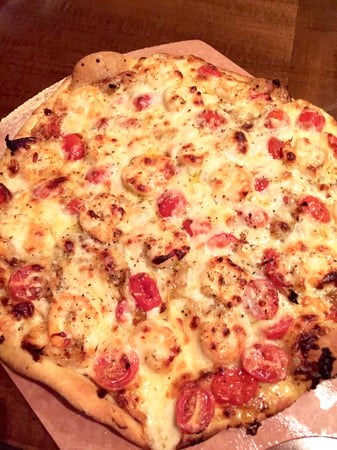
I’ve been on a pizza-making kick for the past six months now. I’ve been having the best time experimenting with pizza dough, choosing and adding a variety of toppings and creating different flavorful sauces for my pies like this Italian Sausage & Cremini Mushroom pizza.
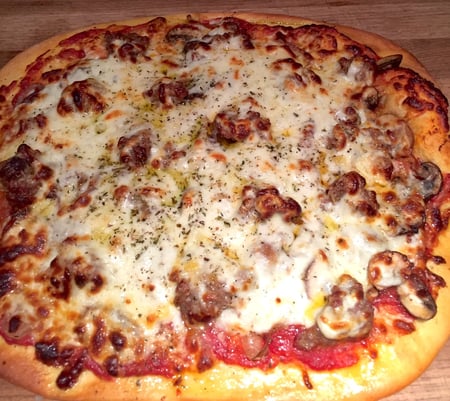
I always tell my students at The Chopping Block, “Anything that can make your life simple while in the kitchen, go for it!” That might include buying already-made pizza dough from your neighborhood grocery store, specialty market or even some restaurants. But hear me out for a moment! How about making your own pizza dough? It’s as simple as yeast, flour, salt, water and olive oil and sometimes a bit of sugar or honey.
The thing I love about making pizza dough is the process of watching the yeast as it begins to ferment with the flour, water and salt. The moment you see your dough beginning to rise just ever so slightly is really a pretty cool feeling! In just an hour or so, you’re going to possess a large fluffy ball of risen, yeasty, bready, goodness.
There are many styles of pizza dough: thin and crisp, thick and chewy and even some with buttery crusts. You need to balance all the ingredients to achieve which crust suits your needs for the pizza you’re creating.
Yeast is what helps in the fermentation process and makes your dough rise. The type of yeast, the temperature of the dough and the temperature of your workroom all play a role in the activity of your pizza dough.
One of my favorite recipes for making pizza dough is one that we teach our students at The Chopping Block. It mentions using “00” flour. This refers to flour that is perfectly suited for pizza dough. That’s because it’s finely ground and it also has lower gluten content than most flours. “00” refers to the texture of the flour after milling. If you cannot find “00” flour in your supermarket, then all-purpose flour will do just fine. Our students love this Neapolitan-Style Pizza Dough recipe! You can either make this dough by hand as the recipe states or you can also use a stand mixer with the dough hook.
Neapolitan-Style Pizza Dough
Yield: 2 large pizzas, or 4 individual pizzas, or 8 mini appetizer pizzas
Active time: 20 minutes
Start to finish: 2 hours
1-cup lukewarm water (110º to 115º)
1-tablespoon active dry yeast
1-tablespoon extra virgin olive oil
2 3/4-cups hard-wheat (“00”) flour (see note, below)
1-teaspoon fine sea salt
1. Sprinkle the yeast on top of water in a large mixing bowl and stir gently until dissolved. Allow proofing until slightly foamy and aromatic to ensure yeast is alive, about 5 minutes.
2. Add oil, most of the flour and salt, and mix until incorporated.
3. Work in most of the remaining flour. Turn out mixture, which may be slightly sticky, onto a floured surface.
4. Knead several times by hand until smooth and elastic, about 10 minutes. Adjust consistency, if necessary, with a small amount of flour. Dough should be barely moist and no longer sticky.
5. Shape dough into a ball, place it in a bowl and cover with plastic wrap.
6. Let the dough rise at room temperature until doubled, 60 to 75 minutes, or in the refrigerator overnight.
7. Punch down the dough; roll out, top and bake according to directions.
“00” (Double Zero) Flour
In Italy, flour is classified either as 1, 0, or 00, referring to how finely the flour is ground and how much have the bran and germ have been removed. Double zero is the most highly refined ground flour from durum wheat, making it high in protein, which results in an extremely elastic dough perfect for pasta, focaccia, pizza and flatbread.
Now that you’ve made your pizza dough, it's time to roll out the dough and add your toppings. After you’ve punched out your dough, place the dough on a lightly floured work surface. With your fingers, begin to gently stretch out the dough into a round circle. If you have a bench scraper around, use it to move the dough around to prevent it from sticking to your work surface. Take your rolling pin and working your way from the center of the dough, roll out your dough in all directions, while still maintaining a circle. Don’t worry if your circle isn’t perfectly round. That’s what we call “rustic”.
Pizza-Making Tools
Some tools that will help you achieve that fresh, out of the oven, restaurant-quality pizza would include a good pizza stone, a pizza peel, a pizza wheel and corn meal. The corn meal acts as tiny ball bearings, allowing your pizza to slide off the peel onto your pizza stone with ease. You might want to consider a nice cast iron skillet if you’re going to make a pan pizza. But you can also use a deep-dish pizza pan.
For a reliable pizza peel I really like the one made by Epicurean. It has a long, sturdy handle and a wide strong base to hold the pizza dough and all of your toppings.
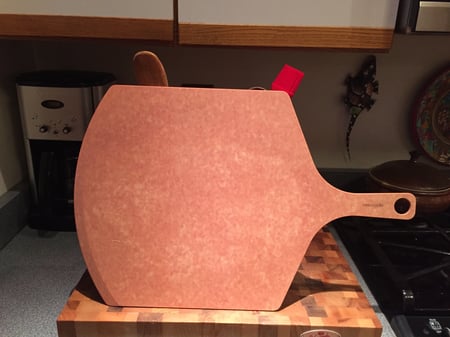
I recommend Emile Henry's French clay pizza stone. It can withstand high oven temperatures and can also be used on your outdoor grill. The glaze is what they call micro-crazed, which contributes to a crispy well baked crust, just like a pizza oven. They also come in a variety of colors, shapes and sizes.
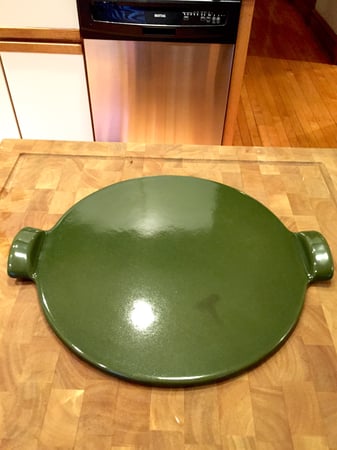
For a great pizza cutter you can’t go wrong with the one made by Rosle because it creates a perfect slice every time. As for a rolling pin, that’s something that I think is very individual. I prefer a rolling pin that doesn’t have any handles. Mine is bamboo, but I also have a wooden one with handles that my sister gave me that was handed down to her from our grandmother. As for cornmeal, well that’s an individual choice as well. I do suggest using good yellow cornmeal.
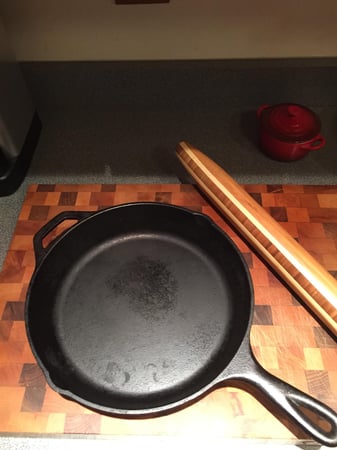
When I’m the mood for a deep-dish pizza, I always use my Lodge cast iron skillet. If you’ve never used cast iron before, it can change your life in the kitchen. The properties in cast iron will help with heat retention and produce even cooking. They can go from stove top to oven, they’re highly durable and will last for generations. I’ve heard stories of cast iron skillets being handed down through several generations.
One of my favorite pizza recipes that we teach our students at The Chopping Block is Prosciutto Pizza Bianca. I’ve made this pizza at home for myself as well as for pizza night with friends. It has never failed to impress. Give it a try. If you’re not a fan of prosciutto or don’t eat meat, you can always leave off the prosciutto.
Prosciutto Pizza Bianca
Yield: One (1) 10-inch pizza
Active time: 20 minutes
Start to finish: 35 minutes
Above recipe for Neapolitan-style pizza dough reduced by half
2-tablespoons garlic grape seed oil
½-cup Ricotta cheese
½-cup Fontana cheese, grated
½-cup Gorgonzola cheese, crumbled
½-cup Parmesan cheese, grated
6 to 8 thin slices of prosciutto
2-tablespoons basil leaves
1. Place a pizza stone, if you are using one, on the lowest rack of the oven. Preheat oven to 450°. Allow the stone to heat for at least 30 minutes.
2. Roll out the pizza dough into a 10-inch round. Transfer the crust to a cornmeal-dusted pizza peel if you will be baking it on a pizza stone. Otherwise, place the dough on a cornmeal-dusted sheet tray.
3. Brush the dough with the garlic grapeseed oil, and then spread with the ricotta cheese. Top with the remaining cheeses and prosciutto.
4. Slide the pizza from the peel onto the pizza stone, or place the sheet tray in the oven. Bake until the cheese is bubbly and the crust is golden brown, 10 to 15 minutes.
5. Top with the basil when the pizza comes out of the oven. Cut into slices and serve.
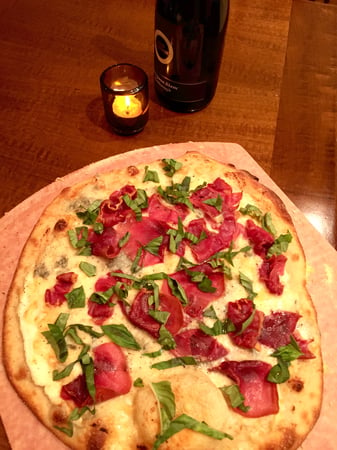
So all you pizza lovers grab some yeast, flour, salt and water. Make some dough. Roll it out. Place it on a pizza peel for a crispy thin crust. Or why not go for Chicago's favorite pan pizza?
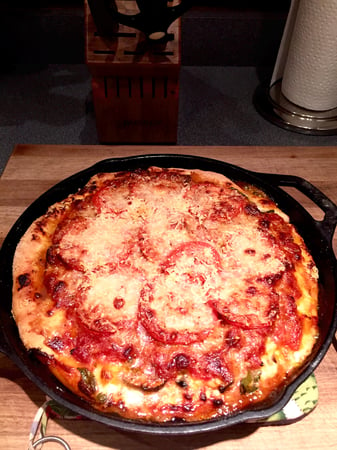
Get creative with toppings, bake your pizza and then enjoy the doughy, cheesy goodness that you’ve now created. And if you want to learn more, take one of The Chopping Block's many pizza-making classes. I myself am quite fond of the Neapolitan Pizza class.











